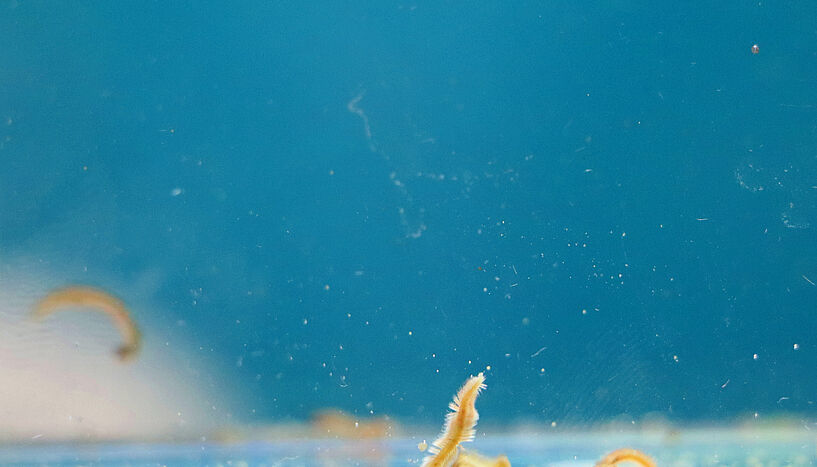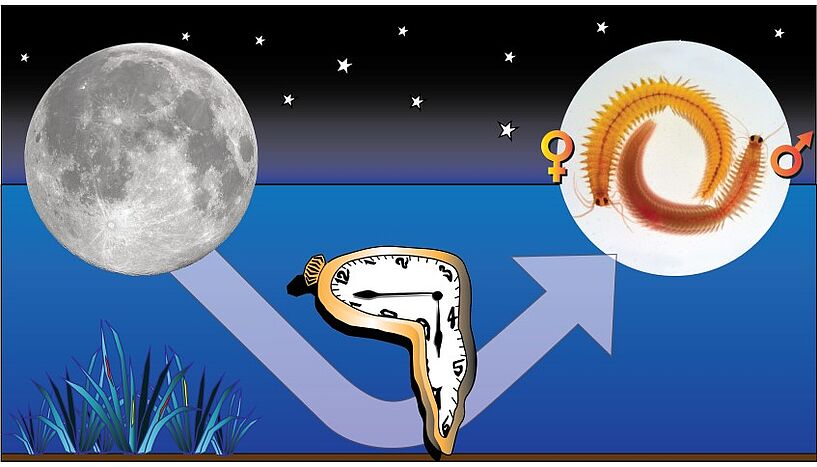Rendezvous at night – how moonlight fine-tunes animal reproduction
01. Juni 2022The study provides an explanation for the phenomenon that daily clocks from flies to humans can exhibit plastic run-times
Animals possess circadian clocks, or 24 h oscillators, to regulate daily behavior. These typically take their cues from the periodic change of sunlight and darkness. However, many animals are also exposed to moonlight, which reoccurs with ~25h periodicity The labs of Florian Raible at the Max Perutz Labs, a joint venture of the University of Vienna and the Medical University of Vienna, and Kristin Tessmar-Raible (Max Perutz Labs, Alfred Wegener Institute, University of Oldenburg) have now discovered that moonlight adjusts the daily clock of marine bristle worms, which helps them to fine-tune their reproductive cycle to certain hours during the night. The study, published in the Proceedings of the National Academy of Sciences, provides an explanation for the phenomenon that daily clocks from flies to humans can exhibit plastic run-times.
In order to produce the next generation, the marine bristle worm Platynereis dumerilii releases its eggs and sperm freely into the open seawater. The correct timing of their reproductive cycles is therefore essential for the survival of the species. It was already known that bristle worms schedule their reproduction to few days of the month. Now, the researchers uncovered that they also synchronize to very specific hours during each night. "We show that moonlight determines when, precisely, during the night the worms start their reproductive behavior, which is always during the darkest portion of the night", explains first author Martin Zurl. Rather than acting as the direct stimulus for swarming, moonlight changes the circadian clock period length. In nature, the time of moonlight changes every day by about 50 minutes. The plasticity of the clock allows the worms to factor in these changes.
The scientists collaborated with the labs of Robert Lucas at the University of Manchester (UK) and Eva Wolf at the Institute of Molecular Biology Mainz and University of Mainz (Germany) to characterize the light receptors involved in this process. They identified that the combinatorial functions of an opsin – closely related to the mammalian circadian photoreceptor melanopsin – and a cryptochrome differentially decode sun- and moonlight to adjust the plastic daily clock. In a collaboration with the lab of Charlotte Helfrich-Förster at the Univer-sity of Würzburg (Germany) the researchers showed that the specific decoding of moonlight is also relevant for the daily clocks of other species.
The impact of light intensity on the period length of circadian clock has been documented for various organisms under artificial lab conditions for decades. However, the physiological relevance of these observations has been unclear. "Our work reveals that there is an ecological meaning behind the observation that the circadian clock of an individual can run with different speeds", explains Kristin Tessmar-Raible. Of note, humans show such circadian plasticity, too. For instance, patients with bipolar disorder exhibit enigmatic circalunidian (i.e.24.8h) periods correlated with their mood switches. The scientists hope that their work will help to understand the origin and consequences of biological timer plasticity, as well as its interplay with natural timing cues.
Original Publication:
Martin Zurl, Birgit Poehn, Dirk Rieger, Shruthi Krishnan, Dunja Rokvic, Vinoth Babu Veedin Rajan, Elliot Gerrard, Matthias Schlichting, Lukas Orel, Aida Ćorić, Robert J. Lucas, Eva Wolf, Charlotte Helfrich-Förster, Florian Raible,and Kristin Tessmar-Raible: Two light sensors decode moonlight versus sun-light to adjust a plastic circadian/circalunidian clock to moon phase. Pro-ceedings of the National Academy of Sciences 2022
Abb. 1: Bristleworms spawning (© Florian Raible University of Vienna)
Wissenschaftlicher Kontakt
Dr. Kristin Tessmar-Raible
Department für Mikrobiologie, Immunbiologie und Genetik - Max Perutz LabsUniversität Wien
1030 - Wien, Dr. Bohr-Gasse 9
+43-1-4277-746 35
+43-664-602 77-746 35
kristin.tessmar-raible@univie.ac.at
Florian Raible
Max F. Perutz Laboratories Universität Wien Vienna Biocenter1030 - Wien, Dr.-Bohr-Gasse 9
+43-1-4277-546 16
+43-664-602 77-546 16
florian.raible@univie.ac.at
Rückfragehinweis
Mag. Alexandra Frey
Media Relations ManagerUniversität Wien
1010 - Wien, Universitätsring 1
+43-1-4277-17533
+43-664-8175675
alexandra.frey@univie.ac.at
Downloads:
20220601_Abb1_01.jpg
Dateigröße: 2,41 MB


